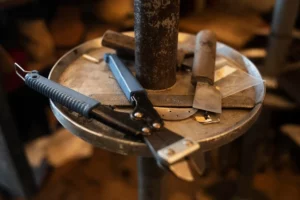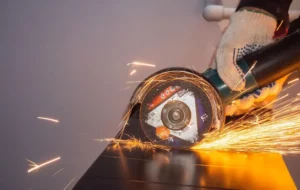Carbide lathe tools are invaluable in machining, known for their durability and efficiency. However, like all cutting tools, they require maintenance to perform at their best. In this guide, we will explore the art of sharpening carbide lathe tools to ensure your machining endeavors continue smoothly. Whether you’re a seasoned professional or a beginner, this guide has you covered.
How to Sharpening Carbide Lathe Tools

Sharpening carbide lathe tools is a skill that can extend the life of your tools and improve the quality of your work. Follow these steps to master the art of sharpening:
Steps for Sharpening Carbide Blades
- Stand Safely Next to the Grinder: Safety first. Position yourself next to the grinder and ensure that no fragments can harm you during the sharpening process.
- Maintain Proper Tool Positioning: Clamp your elbows at your waist to reduce unnecessary vibrations. Keep the turning tool horizontal about the grinding wheel and maintain a tip angle of approximately 3 – 8 degrees.
- Horizontal Tool Movement: Move the tool horizontally in both left and right directions, ensuring that the grinder makes contact with the tool.
- Protect the Cutting Edge: When you need to stop grinding, lift the tool carefully to protect the cutting edge from damage.
Sharpening Brazed Carbide Lathe Tools

Brazed carbide lathe tools require a slightly different approach for sharpening. Here’s how to do it effectively:
- Using a Diamond Stone: Start by wiping off any pitch buildup and inspect the cutter for nicks and chips. If the cutter is damaged, replace it. For sharpening, use a delicate diamond stone with a grit rating between 600 and 1000.
- Applying Lapping Fluid: To prevent rust and clogging, apply a few drops of Lapping Fluid to the stone.
- Circular Motion Sharpening: Place the cutter flat on the stone’s surface and, using light pressure, move it in a circular motion. Look for a black slurry buildup; this indicates that the diamond is effectively sharpening the tool. Continue sharpening for about 30 seconds.
Sharpening Negative Rake Carbide Cutters
Negative rake carbide cutters also require specific attention when sharpening. Here’s a step-by-step guide:
- Creating a Burr with a Diamond File: Begin by sharpening the edge with a diamond file to create a burr.
- Utilizing a Guide Platform: Set up a platform as a guide and make contact with the heel while raising the handle until the edge touches the wheel.
- Sharpening Top and Bottom Edges: Sharpen the top edge when the bottom bevel becomes too small. For the bottom bevel, set the platform to a 60-degree angle. Create guidelines perpendicular and parallel to the edge of the wheel for reference.
Advantages of Carbide Lathe Tools
Understanding the advantages of carbide lathe tools can help you appreciate their worth:
- Durability: Carbide tools are known for their longevity, requiring minimal sharpening compared to other materials. They maintain their edge even under high-speed and heavy-duty operations. However, when sharpening is needed, it’s best to use diamond wheels for effective results.
- User-Friendly: They are beginner-friendly, with no steep learning curve. Their consistent performance allows new users to focus on technique rather than constant tool adjustments.
- Long-Lasting Sharpness: Carbide tips can stay sharp for extended periods, outperforming high-speed steel (HSS) cutters. This makes them ideal for long production runs and demanding materials.
- Efficient Sanding: Carbide turners excel at sanding wood surfaces, even after the turning process. Their sharp edges and stable design help achieve a smooth, consistent finish with minimal effort.
How to Sharpen Lathe Tools by Hand
For those who prefer the hands-on approach, here’s how to sharpen lathe tools manually:
- Setting the Correct Angle: Set your device at an angle of 35 degrees and bevel the edge between 25 and 30 degrees. This ensures optimal cutting efficiency and tool longevity. Regularly check the angle during the process to maintain consistency and avoid uneven sharpening.
- Choosing the Right Stone: Select a stone with a medium-level grit suitable for the tool you intend to sharpen. Coarse-grit stones are necessary for severely dull tools. For finishing, switch to a fine-grit stone to achieve a razor-sharp edge. Always lubricate the stone with oil or water to reduce friction and prevent damage.
- Honing to a Fine Edge: Hold the fine edge against a fine-grit stone and sand away any metal burrs. Use light, consistent pressure to maintain control and avoid over-grinding. Finish by wiping the tool clean to remove any remaining debris or particles.
Sharpening Carbide Tip Blades
Sharpening carbide tip blades requires precision. Here are the steps involved:
- Using Diamond Tips: Diamond tips are ideal for this task due to their hardness. Wet grinding with an abrasive wheel is the best method. Alternatively, consider using a diamond lap, although it may be less precise and more time-consuming.
Sharpening Carbide Concrete Bits
Even carbide concrete bits can be sharpened efficiently.
- Using a Bench Grinder: Utilize a bench grinder to reduce vibrations. This helps maintain tool balance and improves the quality of machining. Always check for wheel alignment and wear before use to ensure safe and effective operation.
- Cooling with Cold Water: Keep the bit at a 60-degree angle and use cold water to cool the tool during sharpening. Always wear goggles to protect your eyes. Ensure the grinding wheel is properly dressed for consistent results. Maintain a firm grip on the tool to avoid slipping or uneven edges.
Conclusion
Properly sharpening carbide lathe tools is crucial for achieving high-quality machining results. Whether you prefer traditional grinding or specialized diamond tools, maintaining the correct angles and techniques ensures your tools remain sharp and durable, ultimately enhancing your machining experience.
Frequently Asked Questions (FAQs)
Are carbide lathe tools good?
Sharpening carbide lathe tools are excellent due to their longevity and ease of use. They require minimal sharpening, making them user-friendly for woodturners of all skill levels.
How do I sharpen lathe tools by hand?
To sharpen carbide lathe tools by hand, set the correct angle, choose the appropriate stone grit, and progressively hone the edge to a fine finish while removing any metal burrs.
Can I sharpen carbide tip blades with diamond tips?
Yes, diamond tips are ideal for sharpening carbide lathe tools. Wet grinding with an abrasive wheel or using a diamond lap are effective methods.




